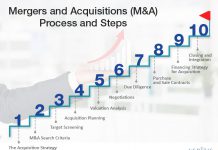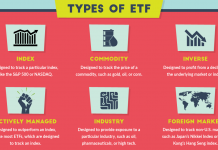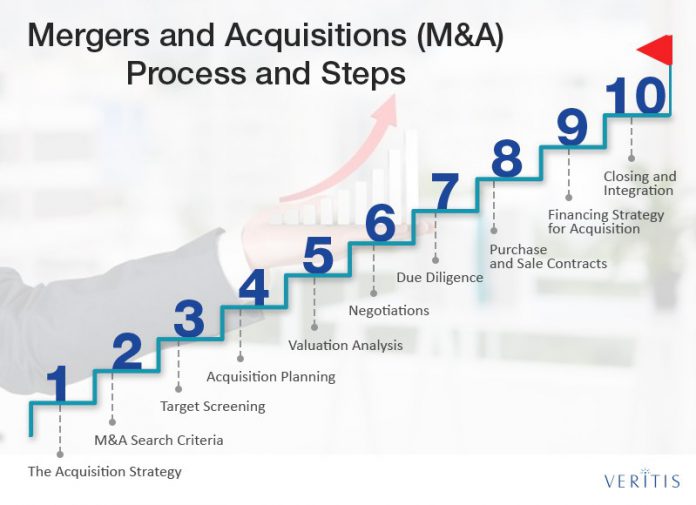Mergers and Acquisitions with Smart Tech Advisory – Process, Steps and Life Cycle
The fast-growing market pace and the need to survive in competition has driven many firms to device several growth strategies.
Firms upgrade existing systems, improvise workflows, adopt new technologies and more, which are enough to achieve short-term growth goals. However, strategies such as M&A help firms achieve long-term.
Big business strategies like Mergers and Acquisitions (M&A) not only give the organizations the impetus for growth but also place these business giants at the forefront of competition.
But how do firms bring about a merger or acquisition in the US?
Let’s take a look at the M&A process.
Technology Mergers and Acquisitions (M&A) Process and Steps:
1) The Acquisition Strategy
The first step in the M&A process is creating a good acquisition strategy! This requires the acquiring company to have a clear idea of what goals they want to achieve from the acquisition – expand product lines or gain access to new markets.
Here are some questions to ensure a successful acquisition strategy:
- What business is the company involved in?
- What is the scope of the business?
- What is the overall direction that our business intends to take toward its market?
These questions will bring your M&A strategy in line with the overall business strategy in the US.
2) M&A Search Criteria
The next step is to identify key criteria for target companies in line with the acquiring firm’s acquisition goals. The criteria could vary based on customer base, geographic location and profit margins.
3) Target Screening
The acquiring firm then begins target screening by assessing the potential targets in line with the acquisition criteria
4) Acquisition Planning
The acquirer will then meet with the target companies and offer a good value for them or their assets. With the initial meeting, the acquiring firm will seek to gain information about the target and see how flexible is the target company with a merger.
5) Valuation Analysis
After the initial conversation, the acquiring firm will ask the target to provide substantial information including current financials, operations, liabilities and more. This helps the acquirer to assess the target’s capabilities as a business on its own and as a potential acquisition firm.
6) Negotiations
After gathering enough information for the evaluation of the target, the initial offer will be rolled out. Then the two firms will negotiate terms in further detail.
7) Due Diligence
This process begins as soon as the offer has been accepted by the buyout company. This makes a reevaluation of the acquirer’s initial assessment of the target’s value by conducting a detailed analysis of the target’s operations such as assets, customers, human resources and more. Due diligence is a concrete step that leaves no room for future concerns or problems
8) Purchase and Sale Contracts
In this stage, a final contract for sale is set up, where both the companies make a decision on the type of purchase agreement – asset purchase or share purchase.
9) Financing Strategy for Acquisition
While the acquiring firm has already considered its financials in the early stages of the deal, the fine details of the financials are put in place only after the purchase and sale agreement has been signed.
10) Closing and Integration
The acquisition deal is closed and representatives of both the firms work together on the merger.
The Mergers and Acquisitions (M&A) Life Cycle
The M&A life cycle categorizes the different M&A processes stages into three broad phases:
1) Strategy
Under this phase, M&A Advisors in the US assess the changes pertaining to the acquirer’s industry and identify growth opportunities and targets in line with the firm’s corporate strategy.
This encompasses creating a portfolio strategy and an operating model assessment, corporate financing or investment banking and strategic alternatives.
Besides, this stage also covers target screening, deal structuring, readiness review, synergy analysis and modeling.
2) Execution
During the execution phase, M&A expert advisors in commercial, financial, HR, IT, operational and tax aspects provide insight into the transition and financing options. The execution phase combines experience and knowledge to bring closure to the complex process.
This stage covers, plan structuring, financial advisory, negotiation support, due diligence, preliminary price allocation, tax structuring and more.
3) Integration
In the final phase, integration or separation will present the acquirer with a set of challenges including costs, timelines and business disruptions, among others. This phase spans integration or separation planning support, developing the sales purchase agreement, financial agreement advisory, finalizing valuation and purchase price, completion statement advisory.
Post-deal closure, M&A advisors organize Day 1 Readiness Transition Service Agreement, synergy support, human capital integration, tax integration and restructuring. Technology M&A Advisors in the US assure of a hassle-free process all throughout the integration phase including end-state planning.
The M&A process brings a series of benefits for both the acquirer and target companies if carried out in a phased and strategic manner. Assessment, evaluation and reevaluation are key to the process at every step, without which the merger or separation can turn out to be unfruitful for both firms.
Above all, strong advisory support can transform the daunting process of M&A into a much-organized system. Considering a merger?
Source: https://www.veritis.com/blog/mergers-and-acquisitions-with-smart-tech-advisory-process-steps-and-life-cycle/
M&A Glossary and Terms
Welcome to CFI’s M&A Glossary of terms and definitions for mergers & acquisitions transactions.
These terms are taken from CFI’s advanced financial modeling course on mergers and acquisitions modeling.
General M&A Terms
Accretion
An improvement in per share metrics post-transaction (after issuing additional shares).
Acquirer
The firm that is purchasing a company in an acquisition – the buyer.
Acquisition
AcquisitionAn acquisition is defined as a corporate transaction where one company purchases a portion or all of another company’s shares or assets. Acquisitions are typically made in order to take control of, and build on, the target company’s strengths and capture synergies.
The purchasing company acquires more than 50% of the shares of the acquired company and both companies survive.
Amalgamation/Consolidation
AmalgamationIn corporate finance, an amalgamation is the combination of two or more companies into a larger single company. In accounting, it refers to the combination of financial statements.
The joining of one or more companies into a new entity. None of the combining companies remains; a completely new legal entity is formed.
Asset Deal
Asset DealAn asset deal occurs when a buyer is interested in purchasing the operating assets of a business instead of stock shares. It is a type of M&A transaction. In terms of legalese, an asset deal is any transfer of a business that is not in the form of a share acquisition.
The acquirer purchases only the assets of the target company (not its shares).
Backward Integration
A company acquires a target that produces the raw material or the ancillaries which are used by the acquirer. It intends to ensure an uninterrupted supply of high-quality raw materials at a fair price.
Bootstrap Effect
One of the poor reasons to make a merger. If the target’s P/E ratio is lower than the acquirer’s P/E ratio, the EPS of the acquirer increases after the merger. However, it is purely an accounting/numerical phenomenon, and no value or synergies are created.
Cash Consideration
The portion of the purchase price given to the target in the form of cash.
Compensation Manipulation
One of the poor reasons to make a merger. Management compensation is according to company performance benchmarked to other companies, so an increase in the size of the company often means an increase in salary for management.
Conglomerate
ConglomerateA conglomerate is one very large corporation or company, composed of several combined companies, that is formed by either takeovers or mergers. In most cases, a conglomerate supplies a variety of goods and services that are not necessarily related to one another.
A merger of companies with seemingly unrelated businesses.
Debt Issuance Fees
Underwriting fees charged by investment banks to issue debt in connection with the transaction.
Dilution
Dilution TemplateThis dilution template helps you identify the impact of dilutive securities on the share price. Dilution can be caused due to a number of dilutive securities such as stock options, restricted and performance stock units, preferred stock, warrants, and convertible debt. Dilution may cause the share price to decline beca
A worsening of per share metrics post-transaction (after issuing additional shares).
Economies of Scale
Economies of ScaleEconomies of scale refer to the cost advantage experienced by a firm when it increases its level of output.The advantage arises due to the
Fixed costs decrease because merged companies can eliminate departments with repetitive functions.
Economies of Scope
Economies of ScopeEconomies of scope is an economic concept that refers to the decrease in the total cost of production when a range of products are produced together rather than separately.
A gain of more specialized skills or technology due to a merger.
Empire Building
One of the poor reasons to make a merger. Management decides to make a merger to increase the size of the company purely for the purpose of ego or prestige.
Equity Issuance Fees
Underwriting fees charged by investment banks to issue equity in connection with the transaction.
Excess Purchase Price
The value of the purchase price over and above the net book value of assets (total purchase price minus the net book value of assets).
Fair Value Adjustments
The increase or decrease in the net book value of assets to arrive at the fair market value.
Friendly Takeover
The board of directors and management of the target company approve of the takeover. They will advise the shareholders to accept the offer.
Forward Integration
A company acquires a target that either makes use of its products to manufacture finished goods or is a retail outlet for its products.
Fully Diluted Shares Outstanding
Diluted Shares OutstandingFully diluted shares outstanding is the total number of shares a company would have if all dilute securities were exercised and converted into shares.
The number of shares a company has outstanding after options, convertible securities, etc., are exercised.
Goodwill
GoodwillIn accounting, goodwill is an intangible asset. The concept of goodwill comes into play when a company looking to acquire another company is
The excess purchase price over and above the target’s net identifiable assets (after fair value adjustments).
Horizontal Integration
Merging of companies in the same lines of business. Usually to achieve synergies.
Hostile Takeover
The board of directors and management of the target company do not approve of the takeover. They will advise the shareholders not to accept the offer.
Identifiable Assets
Net Identifiable AssetsNet Identifiable Assets consist of assets acquired from a company whose value can be measured, used in M&A for Goodwill and Purchase Price Allocation.
An asset that can be assigned a fair value; can include both tangible and intangible assets.
Intrinsic Value
Intrinsic ValueThe intrinsic value of a business (or any investment security) is the present value of all expected future cash flows, discounted at the appropriate discount rate. Unlike relative forms of valuation that look at comparable companies, intrinsic valuation looks only at the inherent value of a business on its own.
The estimated value of a business using discounted cash flow analysis (often on a per share basis).
Merger/Statutory
Statutory MergerIn a statutory merger between two companies (where company A merges with company B), one of the two companies will continue to survive after the transaction has completed. This is a common form of combination in the mergers and acquisitions process.
The purchasing company acquires all of the target company shares/assets; the target company ceases to exist (acquirer survives).
Net Book Value of Assets
Book value of assets minus book value of liabilities.
Offer Price
The price offered per share by the acquirer.
Other Closing Costs
This may include due diligence fees, legal fees, accounting fees, etc., related to the deal.
Pro Forma Shares Outstanding
The number of shares outstanding after the transaction has closed and additional equity has been issued.
Purchase Price Allocation
The breakdown of the total purchase price between net identifiable assets and goodwill.
Restructuring Charges
Any fees or charges related to early debt repayments that are part of a restructuring.
Revenue Enhancements
Increases in revenue that are expected due to cross-selling, up-selling, pricing changes, etc.
Sensitivity Analysis
A method of testing how sensitive certain outputs in a financial model are to changes in certain assumptions.
Share Exchange Ratio
The offer price divided by the acquirer’s share price.
Share Issuance Discount
Any discount (if any) to the current market price that will be used to determine the number of shares the target receives.
Share/Stock Deal
The acquirer purchases all the shares of the target (and assumes all assets and liabilities).
Stock Consideration
The portion of the purchase price given to the target in the form of shares of the acquirer’s stock.
Subsidiary
SubsidiaryA subsidiary (sub) is a business entity or corporation that is fully owned or partially controlled by another company, termed as the parent, or holding, company. Ownership is determined by the percentage of shares held by the parent company, and that ownership stake must be at least 51%.
Acquirer completely takes over the target but preserves the target’s brand for the sake of brand reputation or customer base.
Synergies
M&A SynergiesM&A Synergies occur when the value of a merged company is higher than the sum of the two individual companies. 10 ways to estimate operational synergies in M&A deals are: 1) analyze headcount, 2) look at ways to consolidate vendors, 3) evaluate any head office or rent savings 4) estimate the value saved by sharing
Cost savings and revenue enhancements that are expected to be achieved in connection with a merger/acquisition.
Takeover Premium
Takeover PremiumTakeover premium is the difference between the market value (or estimated value) of the company and the actual price to acquire it.
The percentage above the target’s current share price (or VWAP) the offer price represents.
Target
The firm that is being acquired (the seller).
Timing of Synergies
How long it is estimated to take to realize the synergies in the transaction.
Transaction Close Date
The date on which the transaction is expected to be officially completed.
Vertical Integration
Vertical IntegrationA vertical integration is when a firm extends its operations within its supply chain. It means that a vertically integrated company will bring in previously
Merging with companies that are in a company’s supply chain; may be composed of both forward and backward integration.
VWAP
Volume Weighted Average Price, often used in reference to the takeover premium (e.g., 15% above the 20-Day VWAP).
M&A Glossary – Takeover Strategies
Black Knight
Black KnightIn corporate finance, a company that is offering or executing a hostile takeover of the target company is termed a black knight. A hostile takeover is an acquisition attempt by a company or raider that the target company resists.
An unwelcome takeover bidder.
Creeping Takeover
Creeping TakeoverIn mergers and acquisitions (M&A) a Creeping Takeover, also known as Creeping Tender Offer, is the gradual purchase of the target company’s shares. The strategy of a creeping takeover is to gradually acquire shares of the target through the open market, with the goal of gaining a controlling interest.
Acquirer slowly, over a period of time, buys the shares of the target in the stock market to gain a controlling interest in the company.
Dawn Raid
A takeover attempt that buys all available shares of the target company at the current market price as soon as the stock exchange is open for business.
Godfather Offer
Acquirer presents an attractive takeover that the target company cannot refuse. A godfather offer does not have negative implications that are usually associated with this type of takeover offer, including a change of the management team, asset stripping, or transfer of reserves.
Tender Offer
Tender OfferA tender offer is a proposal that an investor makes to the shareholders of a publicly traded company. The offer is to tender, or sell, their shares for a specific price at a predetermined time. In some cases, the tender offer may be made by more than one person, such as a group of investors or another business. Tender offers are a commonly used means of acquisition
Acquirer offers an attractive price to target shareholders to sell their shares in the case of a clean takeover bid.
Toehold Position
Purchasing less than 5% of a company’s shares – to obtain a significant equity position, perhaps aiming to eventually gain a controlling interest, but a small enough purchase to avoid having to notify regulatory authorities.
M&A Glossary – Hostile Takeover Defenses
Crown Jewels Defense
Crown Jewel DefenseThe Crown Jewel Defense strategy in mergers and acquisitions (M&A) is when the target of a hostile takeover sells some of its valuable assets to reduce its attractiveness to the hostile bidder. The crown jewel defense is a last-resort defense since the target company will be intentionally destroying part of its value, with the hope that the acquirer drops its hostile bid.
Target selling the most valuable parts of the company (crown jewels) if a hostile takeover occurs. This deters acquirers from pursuing the hostile takeover.
Dead-hand Provision
The provision requires that anti-takeover defenses can only be canceled by a vote of the board, so acquirers who want to avoid the consequences of the defenses must receive approval from the board before initiating a takeover.
Flip-in
Target company’s shareholders can purchase more shares of its stock at a discount. This dilutes the stock, making it more expensive and difficult for a potential acquirer to obtain a controlling equity interest (more than 50% of voting shares).
Flip-over
Target company’s shareholders can buy the post-merger (acquirer) company’s stock at a discount. Target company is counterattacking by diluting the acquirer’s stock.
Golden Parachute
Golden ParachuteA golden parachute, in mergers and acquisitions (M&A), refers to a large financial compensation or substantial benefits guaranteed to company executives upon termination following a merger or takeover. Benefits include severance pay, cash bonuses, and stock options.
An employment contract that guarantees extensive benefits to executives if they are made to leave the company. This allows executives to remain in the company even after a merger.
Greenmail
GreenmailCommitting Greenmail involves buying a significant number of shares in a target company, threatening a hostile takeover, and then using the threat to force
Target company repurchasing stock from the acquirer or a third party for a premium price to avoid the stock falling into the hands of the acquirer.
Killer Bees
Public relations firms, law firms, or investment bankers hired by a target company to help fend off a hostile takeover.
Lobster Trap
Restricting individuals with large amounts of convertible securities from converting if by doing so the individual is going to hold 10% or more of the target’s shares.
Pac Man Defense
Pac-Man DefenseThe Pac-Man Defense is a strategy used by targeted companies to prevent a hostile takeover. This takeover prevention strategy is implemented by the target company turning things around by trying to take over the acquirer. The purpose of the Pac-Man Defense is to make a takeover very difficult Example of pac-man defense
Target company of a hostile takeover turns around and attempts to obtain controlling shares of the acquirer.
Poison Pill
Poison PillThe Poison Pill is a structural maneuver designed to thwart attempted takeovers, where the target company seeks to make itself less desirable to potential acquirers. This can be accomplished by selling cheaper shares to existing shareholders, thereby diluting the equity an acquirer receives
Any of several hostile takeover defenses designed to discourage the acquirer from pursuing the takeover.
Poison Put
Target companies allow bondholders to sell bonds back at a premium to make hostile takeovers costlier.
Sandbagging
SandbaggingSandbagging occurs when a person or company intentionally lowers its expectations for success with the goal of producing greater than expected
Target company playing along with the hostile bid and stalling for time while waiting for a white knight to appear.
Scorched Earth Policy
Target borrows money at extremely high interest rates to make takeover unattractive. It’s a double-edged sword because although the takeover is prevented, the company may be destroyed by crippling debt.
Show-stopper
Target starting litigation to thwart an attempt at a takeover.
Supermajority Amendment
A requirement that a very large percentage of shareholders approve of major decisions of the company – an attempt to fend off hostile takeovers.
White Knight Defense
White Knight – A white knight is a company or an individual that acquires a target company that is close to being taken over by a black knight. A white knight takeover is the preferred option to a hostile takeover by the black knight, as white knights make a ‘friendly acquisition’ by generally preserving the current management team
A friendly takeover bidder that outbids the Black Knight.
White Squire Defense
White Squire – A white squire is an individual or company that buys a large enough stake in the target company to prevent that company from being taken over by a black knight. In other words, a white squire purchases enough shares in a target company to prevent a hostile takeover.
An ally of the target company that does not buy enough shares to gain a controlling interest, but enough to prevent the hostile takeover acquirer from gaining a controlling interest.
Additional resources
Thank you for reading CFI’s M&A Glossary of terms and definitions for understanding mergers and acquisitions. These terms were taken from CFI’s advanced Mergers and Acquisitions Modeling Course.
To keep learning and advancing your career these CFI resources will be a big help:
- M&A ProcessMergers Acquisitions M&A ProcessThis guide takes you through all the steps in the M&A process. Learn how mergers and acquisitions and deals are completed. In this guide, we’ll outline the acquisition process from start to finish, the various types of acquirers (strategic vs. financial buys), the importance of synergies, and transaction costs
- Horizontal MergersHorizontal MergerA horizontal merger occurs when companies operating in the same or similar industry combine together. The purpose of a horizontal merger is to more
- Types of SynergiesTypes of SynergiesM&A synergies can occur from cost savings or revenue upside. There are various types of synergies in mergers and acquisitions. This guide provides examples.
- Deal & Transaction ResourcesDeals & TransactionsResources and guide to understanding deals and transactions in investment banking, corporate development, and other areas of corporate finance. Download templates, read examples and learn about how deals are structured. Non-disclosure agreements, share purchase agreements, asset purchases, and more M&A resources
Source: https://corporatefinanceinstitute.com/resources/knowledge/deals/mergers-acquisitions-ma-glossary/

















